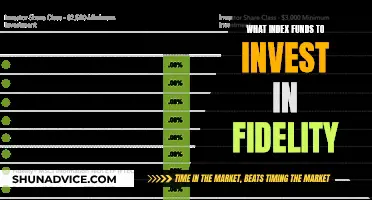
Mutual funds are a popular investment option for many people. They are a type of investment vehicle that pools money from multiple investors to purchase a diversified portfolio of stocks, bonds, or other securities. This provides investors with the opportunity to invest in many different companies with a single purchase. Mutual funds are typically traded once per day and are often owned as part of a defined contribution retirement plan, such as a 401(k) or an individual retirement account (IRA). There are several types of mutual funds, including stock, bond, money market, and target-date funds, each with its own investment focus and strategy. When choosing a mutual fund, it is important to consider factors such as fees, investment goals, risk tolerance, and the fund's performance over time.
| Characteristics | Values |
|---|---|
| Investment Options | Stocks, bonds, money market accounts, and other investments |
| Management | Managed by financial professionals |
| Investor Resilience | Diversified portfolio |
| Investor Resilience | Not putting all your eggs in one basket |
| Investor Resilience | More resilient to market changes |
| Investor Profile | Investors in 401(k)s, Roth IRAs, and other retirement investment accounts |
| Investment Horizon | Long-term investment |
| Investment Amount | Minimum investments range from zero to $3,000 |
| Age Considerations | The closer you are to retirement age, the lower your risk tolerance |
| Types | Money market funds, bond funds, stock funds, target-date funds |
| Fees | Expense ratio, 12b-1 fee, front-end load, back-end load, deferred load |
What You'll Learn

Mutual fund fees and expenses
Mutual funds are a great way to make an investment, especially if you are willing to stick it out for the long term. However, mutual fund fees can take a significant chunk out of your investment returns. It is important to be aware of the different types of fees and expenses that come with investing in mutual funds.
Mutual fund fees generally fall into two categories: annual fund operating expenses and shareholder fees.
Annual Fund Operating Expenses
These are ongoing fees that cover the cost of paying managers, accountants, legal fees, marketing, and more. These fees are typically between 0.25% and 1% of your investment in the fund per year and are also known as mutual fund expense ratios or advisory fees. Actively managed funds tend to have higher expense ratios than passively managed funds. The total annual fund operating expenses are expressed as a percentage of the fund's net average assets.
The following are some of the fees that may be included in annual fund operating expenses:
- Management fees: The cost of paying fund managers and investment advisors.
- 12b-1 fees: Fees capped at 1% that cover marketing and selling the fund, as well as other shareholder services.
- Other expenses: Custodial, legal, accounting, transfer agent expenses, and other administrative costs.
Shareholder Fees
Shareholder fees are sales commissions and other one-time costs incurred when buying or selling mutual fund shares. These fees are typically listed in the fund's prospectus under the heading "Shareholder Fees."
- Sales loads: Commissions paid to third-party brokers when buying or selling shares. These can be front-end loads (paid when purchasing shares) or back-end loads (paid when selling shares).
- Redemption fee: Charged when an investor sells their shares within a short period of purchasing them.
- Exchange fee: Charged when an investor exchanges shares for another fund offered by the same investment company.
- Account fee: A fee for maintaining an account, often applied when the balance falls below a specified minimum.
- Purchase fee: Charged when purchasing shares, distinct from a front-end sales load.
It is important to carefully consider the fees associated with a mutual fund before investing. Even small differences in fees can lead to significant differences in returns over time.
Mutual Fund Investment: Strategies, Risks, and Rewards
You may want to see also

Types of mutual funds
Mutual funds are generally categorised into four main types: money market funds, bond funds, stock funds, and target date funds. Each type has its own unique features, risks, and potential rewards.
Money Market Funds are considered a safe investment option with relatively low risks. These funds primarily invest in short-term debt instruments, such as government treasury bills, and are known for their low returns. They are often used as temporary storage for cash that will be invested elsewhere in the future.
Bond Funds aim for higher returns and thus carry greater risks compared to money market funds. The level of risk and reward can vary significantly depending on the specific type of bonds in the fund. Some common types include government and corporate bonds, as well as high-yield junk bonds.
Stock Funds invest in corporate stocks and can be further categorised into growth funds and income funds. Growth funds focus on stocks with high return potential rather than regular dividend payouts. Income funds, on the other hand, generate profits primarily through regular dividend payments.
Target Date Funds, also known as lifecycle funds, are designed for individuals with specific retirement dates in mind. These funds hold a mix of stocks, bonds, and other investments, and the asset allocation gradually shifts over time according to the fund's strategy.
Other types of mutual funds include index funds, which mirror the performance of a specific market index like the S&P 500, and sector funds, which specialise in a particular industry segment.
Best Vanguard Index Funds to Invest $1000 Minimum
You may want to see also

Pros and cons of mutual funds
Mutual funds are a popular investment option for many people. They are diverse by nature and can help reduce investment risk. However, there are pros and cons to investing in mutual funds.
Pros of Mutual Funds
Mutual funds are a type of investment vehicle that pools money from multiple investors to invest in a variety of investment types. They are diverse by nature and can help reduce investment risk. Some other pros of mutual funds include:
- Diversification: Mutual funds allow you to invest in a variety of different types of stocks and bonds from a number of industries. This strategy exposes you to less risk than purchasing individual securities, as one holding’s poor performance may be offset by others performing well.
- Small investment amounts: You may be able to make smaller contributions that can grow over time.
- Professional money management: Mutual funds provide professional management, ongoing supervision of your holdings, and automatic diversification.
- Liquidity: Shares can be redeemed on any business day, and because shares of a mutual fund are priced daily, you always know the value of your investment.
- Potential outperformance: The people managing your funds want you to beat the market so that they can attract more potential investors and have a greater pool of resources to work with.
Cons of Mutual Funds
- Fees and charges: Mutual funds often come bundled with fees that are greater than those of many other forms of investment. There are various fees to consider, including load fees, operating expense ratios, and 12b-1 fees.
- Historical underperformance: A large percentage of mutual funds have fallen short of their stated goals in the past 15 years.
- Taxes: Unless you're working with a tax-advantaged account, you'll have to pay taxes on your investment every year.
- Poor trade execution: Mutual funds provide a weak execution strategy for investors looking for faster execution times, perhaps because of short investment horizons, day trading, or timing the market.
- Too hands-off: Some investors like being involved in trades and investment decisions, but with a mutual fund, a fund manager might handle those details on their behalf.
Mutual Funds: US Market Investment Options for Indians
You may want to see also

How to choose a mutual fund
There are thousands of mutual funds available, so it's important to understand your financial goals and risk tolerance before investing. Here's a guide on how to choose a mutual fund:
Define your objectives
First, consider what you are working towards and by when you'd like to reach your target. Ask yourself: What milestone are you investing for? How long can you invest for? How much risk can you take on? Do you want your investment to grow, or are you happy with the amount staying the same?
Define your time horizon
Historically, the stock market trends upwards over time, so investing in the stock market is a popular strategy for retirement. Investment professionals generally advise against short-term investments, with some saying less than three years isn't worth it.
Evaluate historical returns
Look at a fund's performance over the past 5, 10, or 15 years to understand how it performs during economic booms and busts. If it has underperformed or hasn't been operating for long, consider other options.
Seek lower fund turnover
Portfolio turnover is the rate at which a fund buys and sells stocks. A high turnover means stocks aren't held for long and can result in a greater tax liability. Generally, you'll want your fund to have a turnover rate of no greater than 20%.
Active vs passive management
Active management involves professionals buying and selling investments for the fund, and it's proved very difficult to outperform the market over the long term in this way. Passive investing, on the other hand, tracks an existing market index and tends to be cheaper and perform better.
Costs
Costs are an important consideration when selecting a fund. The expense ratio is the percentage of assets paid to run the fund, and there may be additional transaction fees. These fees can add up considerably, so always be aware of the expense ratios across your investments.
Risk tolerance
Generally, the closer you are to retirement age, the more holdings in conservative investments you may want to have. Younger investors typically have more time to ride out the highs and lows of the stock market.
Asset allocation
If you're just starting out, it may be a good idea to look into broad mutual funds that invest in different areas of the stock market. One way to do this is by looking at a market index, like the S&P 500, which covers around 500 of the largest companies in the US.
Mutual fund alternatives
Exchange-traded funds (ETFs) are a good alternative to mutual funds, typically with lower expense ratios and no load fees. They also give investors easier access to leverage.
Due diligence
Do your research before choosing a mutual fund. Look into the particular strategy of individual investment options, consider how much the manager has invested in the fund, how long the fund holds the securities it buys, and how capable the company that manages the fund is.
Smart Ways to Invest Your Rainy Day Fund
You may want to see also

How to invest in mutual funds
Investing in mutual funds is a great way to get exposure to a wide range of securities with a relatively small investment. Here is a step-by-step guide on how to invest in mutual funds:
Understand the different types of mutual funds:
Mutual funds can be categorised based on the types of investments they hold:
- Stock mutual funds (or equity funds) invest in shares of public companies and offer higher potential returns but also come with higher risk.
- Bond mutual funds (or fixed-income funds) invest in various forms of debt, such as government or corporate bonds, and provide more stable returns.
- Balanced funds (or blended funds) invest in a mix of stocks and bonds, offering a balance between risk and return.
- Money market mutual funds invest in short-term, high-quality debt and are considered low-risk, low-return investments.
- Target-date funds are designed for retirement savings and adjust their mix of stocks, bonds and other securities based on the investor's target retirement date.
Decide between active and passive funds:
Active funds are managed by professionals who actively buy and sell securities to try to beat the market. Passive funds, on the other hand, aim to mimic the performance of a market index and are often less expensive.
Calculate your investing budget:
Consider how much money you can comfortably invest. Mutual funds typically have minimum investment requirements, which can range from as low as $100 to a few thousand dollars.
Choose a brokerage account:
You can buy mutual funds through an online brokerage, directly from the fund company (e.g. Vanguard or BlackRock), or with the help of a financial advisor. When choosing a brokerage, consider factors such as affordability, fund choices, research tools, and ease of use.
Understand the fees:
Mutual funds come with various fees that can eat into your returns, so it's important to understand them before investing. These include expense ratios, sales loads, 12b-1 fees, redemption fees, exchange fees, and purchase fees.
Evaluate the fund's performance and turnover:
Look at the fund's historical returns over the past 5 to 10 years to get a sense of how it has performed during different market conditions. Also, consider the portfolio turnover rate, which indicates how frequently the fund buys and sells stocks. A high turnover rate may result in higher taxes.
Invest in the mutual fund:
Once you've done your research and due diligence, it's time to make your investment. You can purchase mutual funds through an online brokerage, and the price will be based on the fund's net asset value (NAV) at the end of the trading day.
Equity Funds: Where to Invest and Why
You may want to see also
Frequently asked questions
A mutual fund is a portfolio of stocks, bonds, money market accounts, and other investments that are managed by financial professionals. Mutual funds allow investors to invest in many different companies with a single purchase.
There are many types of mutual funds, including stock funds, bond funds, money market funds, and target-date funds. Stock funds can be further divided into growth funds and income funds.
Mutual funds offer instant diversification, allowing investors to become more resilient by spreading their investments across multiple assets. Mutual funds are also managed by professionals, saving investors time and effort.
Mutual funds often come with high fees and may underperform the market. Additionally, buying and selling stocks within the fund can create taxable events, resulting in capital gains taxes.
When choosing a mutual fund, consider your investment goals, risk tolerance, time horizon, and fees. Evaluate the fund's historical returns, fund turnover, and the track record of the investment manager.







